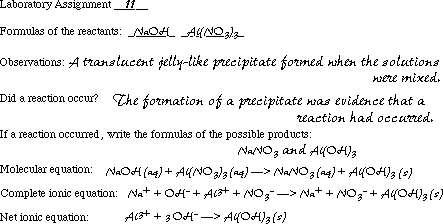Metathesis Reactions
Objectives
- Careful observation and detailed description of chemical reactions in solution
- Inferring from observation and from other information whether or not a reaction actually takes place
- Writing the reactions that take place in the shorthand language of chemistry: chemical equations (molecular, complete ionic, and net ionic)
Predicting the Products of Metathesis Reactions
Products of metathesis ("double replacement") reactions are obtained by interchanging the ions produced by dissociation of the reactants.
AB + CD --> AD + CB
AgNO3 + NaI --> AgI + NaNO3
Predict reaction products given reactants Na2SO4 and AlCl3:
- Identify reactant ions
2 Na+ + SO42- and Al3+ + 3 Cl-
- Interchange the ions
Na+ + Cl- and Al3+ + SO42-
- Write correct formulas for the products (i.e., form the ions into compounds):
NaCl from Na+ + Cl-
Al2(SO4)3 from Al3+ + SO42-
- Write the complete molecular equation for the reaction
Na2SO4 + AlCl3 --> NaCl + Al2(SO4)3
- In order to write a complete ionic equation for the reaction, write all soluble reactants and products as separated ions, for that is how they exist in solution:
Na+ + SO42- + Al3+ + Cl- --> Na+ + Cl- + Al2(SO4)3
Note: in general, all of the reactants are soluble but not all of the products if an overall reaction occurred
Note: Don't worry about balancing the equation, but get the formulas of the species involved right.
- In order to write a net ionic equation, remove the spectator ions from the complete ionic equation. The spectator ions are the free ions that are unchanged in the reaction, so they appear on both sides of the complete ionic equation.
SO42- + Al3+ --> Al2(SO4)3
Note: the net ionic equation involves only the product of the reaction that is the driving force of the reaction (see below), and the reactant ions that lead directly to that product.
The Net Chemical Reaction
Observation of one of the following is evidence for a net chemical reaction:
- Heat is evolved
- A precipitate forms (i.e., one product is insoluble in water)
- A weak electrolyte is produced (most important example, H2O)
- A gas is evolved
These may be understood in terms of the "driving force" of a chemical reaction. That is, the rearrangement of ions in a double replacement reaction is likely to occur if the rearrangement leads to products that are energetically favored over the reactants; otherwise, no rearrangement is likely, and no reaction occurs. Formation of precipitates or gases is a sign that new bonds formed from the free ions in solution, resulting in a more stable product that comes out of solution. Evolution of heat is also a sign that the product (whatever it is) is lower in energy (more stable) than the reactants. Thus, we can infer that a reaction occurs if rearrangement of the ions produces one of the above observable results.
Procedure
Note: the following is not a procedural check-list; that is contained in the lab handout. This is a brief summary of that procedure including tips, suggestions, and deviations from the procedure detailed in the handout. It is not a substitute for reading the procedure in the handout before coming to lab.
You will work with all 10 combinations of reactants described in the lab handout. The reagent bottles will be found on the reagent counter next to each fume hood. Reagent bottles are arranged in numbered locations that coincide with the numbers of laboratory assignments described in the lab handout.
You may work in pairs: no triples.
- Measure 3 mL of water in a graduated cylinder, transfer the water to a test tube, and put the test tube in a test tube rack. Use this test tube to measure (estimate) 3 mL of each reactant solution.
- Measure 3 mL of the solutions of a designated pair into each of two test tubes. Pour the second reagent into the test tube containing the first. Thoroughly stir for about 15 seconds.
- Carefully observe the reaction mixture and record your observations on the data sheet.
- After each reaction, discard the reaction mixtures in the appropriately labeled container. Thoroughly clean the test tubes and stirring rod.
- Write a chemical equation for the reaction in each of the following forms, as directed ...
- Molecular equation: All reactants and products written as undissociated, neutral molecular or formula units.
- Complete ionic equation: All strong electrolytes written as dissociated ions; weak electrolytes, precipitates, and gases are written as undissociated formula or molecular units.
- Net ionic equation: Only "reacting" ions and associated product (the reaction's "driving force") are shown. All other ions are termed "spectator" ions (not shown).
Sample Data Sheet

Reading (translating) some net ionic equations
| Al3+(aq) | + | 3 OH-(aq) | --> | Al(OH)3(s)
|
| any soluble aluminum compound | reacts with | any soluble hydroxide | and yields | a precipitate of aluminum hydroxide
|
|
| H+(aq) | + | OH-(aq) | --> | H2O
|
| any acid | reacts with | any base | and yields | water
|
|
| H+(aq) | + | CO32-(aq) | --> | H2CO3(aq) | --> | CO2(g) | + H2O
|
| any acid | reacts with | any carbonate | ... | and yields | ... | carbon dioxide gas | and water
|
 Back to the Chemical Principles Lab Schedule.
Back to the Chemical Principles Lab Schedule.

 Back to the Chemical Principles Lab Schedule.
Back to the Chemical Principles Lab Schedule.